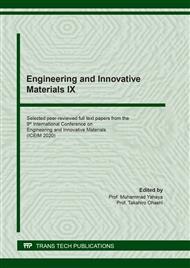p.23
p.29
p.35
p.43
p.49
p.57
p.63
p.71
p.77
Casting of Al-Mg Strip Using Single Roll Caster Equipped with a Scraper
Abstract:
A scraper was attached to an unequal-diameter twin-roll caster without requiring large modifications. This caster was used as a 1000 mm diameter single roll caster equipped with a scraper, and its strip casting ability was tested. The effects of the scraper angle and load, the roll speed, and the pouring temperature of the molten metal on the scribed surface, thickness distribution and average strip thickness were investigated. The scribed surface characteristics were sound and the thickness distribution was flat when the scraper angle was 60° and the scraper load was in the range of 1 to 4 kg. When the scraper load was more than 1 kg, the thickness distribution was uneven. The average strip thickness decreased as the roll speed increased. The pouring temperature of the molten metal influenced the evenness of the solidified layer thickness. The solidified layer became even as the molten metal temperature was decreased. A strip cast with the determined optimal conditions was then cold rolled down to 1 mm to improve its surface quality.
Info:
Periodical:
Pages:
49-56
Citation:
Online since:
March 2021
Authors:
Keywords:
Price:
Сopyright:
© 2021 Trans Tech Publications Ltd. All Rights Reserved
Share:
Citation:


